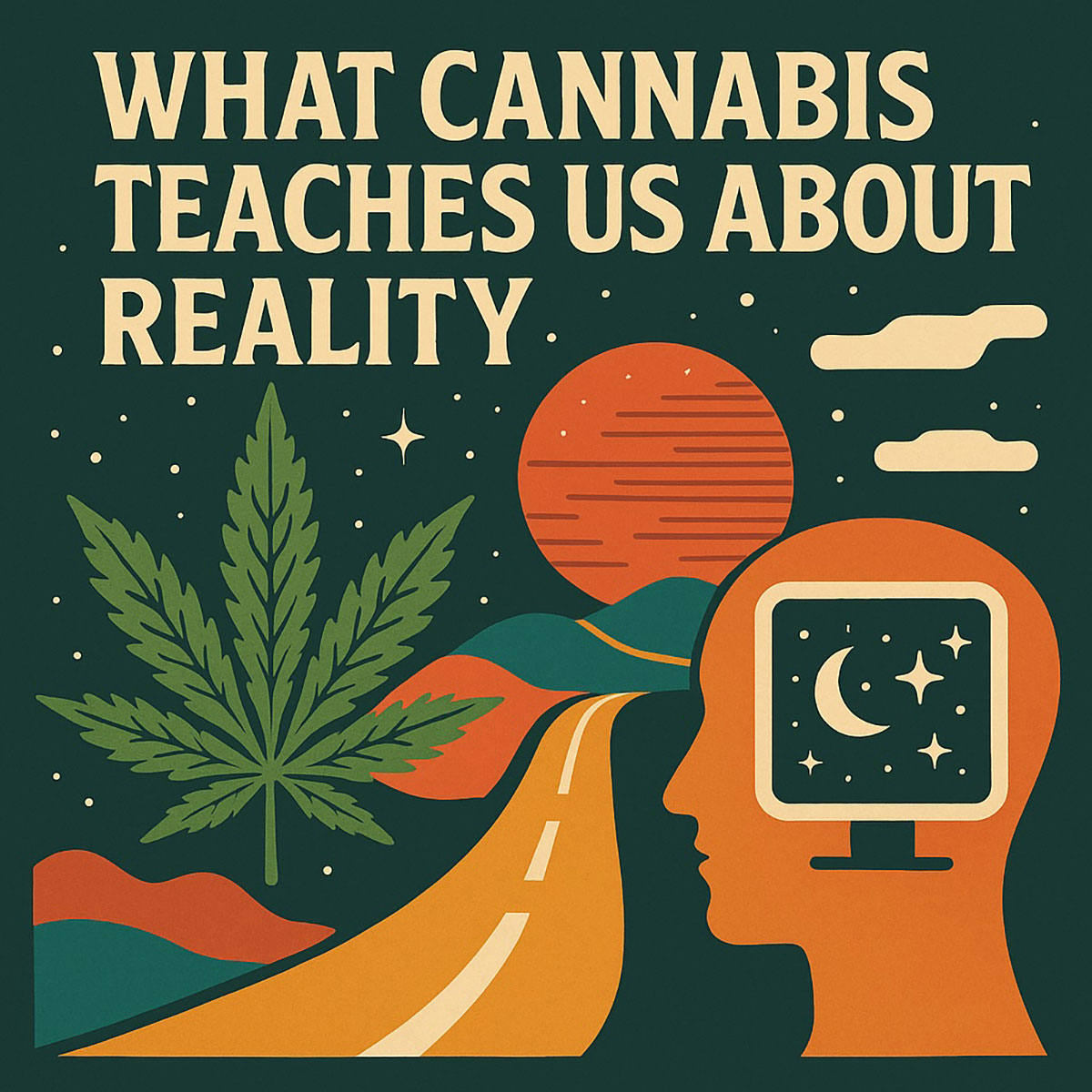Author: Dr. Kim, Medical Doctor at Aurea Care (Pen name)
Reality is supposed to be solid. The ground under your feet. The clock on the wall. The self inside your head that says, I am me.
But at higher doses (especially edibles) cannabis pokes holes in that solidity. Minutes stretch into hours or vanish altogether. You check the clock and realize it’s still 4:20 p.m., just like ten minutes ago. Only it’s been an hour. Or a lifetime. Hard to say. The boundaries of self blur until you can’t tell where you end and the room begins. Colors brighten, music feels alive, food tastes cosmic. Even the expired dry cereal you found behind the toaster.
The physics are the same. Same photons, same sound waves, same molecules. The senses turn those inputs into neural signals, and the brain assembles a scene. Change the brain’s chemistry and the assembly shifts. Whether in ordinary waking consciousness or an altered state, you’re looking at versions, not the source. And because every version runs through the same interface, none can step outside to check what reality is like before the mind gets involved.
Which raises a question medicine rarely asks and philosophy can’t stop asking: if neither ordinary waking consciousness nor an altered state has privileged access to base reality, what, exactly, is “real”?
The Simulation You Already Live In
We never get reality in its original format. By the time it reaches you, your brain has already run it through its editing suite: cropped the frame, color-graded the footage, and layered in a soundtrack. What you get isn’t the source. It’s the director’s cut your nervous system can understand.
And whatever the original is—whatever base reality might be—it’s not just unseen. It’s inaccessible. You can’t touch it, picture it, or imagine it. Because the moment you do, you’ve already rendered it into something else. That’s the paradox: to perceive reality is to lose it.
Take light. Outside your head it’s electromagnetic waves; photons with different energies. To us, light shows up as color. But photons don’t come pre-colored; they aren’t red or blue. Color is something your brain paints over physics. Useful for spotting ripe fruit, reading faces, or seeing a brake light in the rain. Even shapes are guesses, stitched from edges, contrast, and depth cues. The photons don’t carry IKEA blueprints. Your brain extrapolates from the outlines and decides: probably a couch. Sit at your own risk.
Same with sound. Out there you have pressure waves in air. Hair cells in your inner ear bend, nerves fire, and the brain builds sound: music, noise, the neighbor’s dog at 3 a.m. There’s no music floating out there in space. Just pressure waves in the air. Your brain’s the DJ.
That’s perception’s job: translate physical signals into neural code and assemble a scene you can act on. It’s a translation of base reality, not a mirror. Evolution optimized for usefulness, not truth. The tiger’s roar matters; its exact frequency plot does not.
So what we call “reality” is a simulation. A second-order draft of base reality written in the brain’s private language. A human interface to a world we’ll never see directly. Not reality itself, but a survival-ready hallucination of it.
Different species run different reality simulations. A bat maps the world with echolocation. A mantis shrimp sees colors we don’t even have names for. A dog builds its reality around scent. Even among humans, the model isn’t fixed. Psychedelics, fasting, sensory deprivation, and meditation can all shift it. Feed the brain a high dose of THC and it renders a different simulation. Time stretches, music glows, and you may briefly forget where your arm ends and the couch begins. (Pro tip: don’t reach for hot tea.) Same physics, new stitching. That’s the tell.
What we call “reality” says more about us than it does about the world beyond our senses. Cannabis doesn’t rewrite physics. It just changes which version of reality shows up on your internal screen.
You Are the Box
Modern medicine is comfortable asking: Does cannabis relieve pain, anxiety, insomnia? Fair questions. But there’s a deeper one it rarely touches: What does cannabis reveal about reality itself?
Cannabis reveals that the self isn’t fixed. That the “solid” world is a rendering, assembled from sensory receptors, brain chemistry, and whatever state of mind you happen to be in. It shows that we live inside a brain-generated model of a world we’ll never see directly, forever separated from base reality by the filters of biology.
Your brain isn’t a camera. It’s a real-time renderer with a ruthless compression algorithm, dropping most of the data, filling in the blanks, and handing you something that works well enough to keep you alive. Usually.
So what we think of as “the world out there” is actually relational. It arises at the interface between base reality and a nervous system able to interpret it. That interface is you.
We like to imagine we’re in the universe like marbles in a box. But we’re not in the box. We’re the aperture the universe looks through to see itself. And what it sees isn’t raw. It’s a human rendering: the sunrise, the night sky, the heartbreak, the laughter, the Golden Gate Bridge, the falling leaf. All of it: you.
You’re not in the box. You are the box.
Where Worlds Are Made
Cannabis shows how little of life is lived in direct contact with reality.
What we call experience isn’t an experience of the world. It’s an experience of yourself responding to the physics of base reality. What you get is a reconstruction, built from a long chain of translation: sensation into signal, signal into chemistry, chemistry into meaning.
We don’t perceive the world. We perceive the rendering. And cannabis makes that chain visible.
How? Two ways.
First, it slows the edit. It lets you watch perception build itself in real time. Suddenly, you’re not just in the simulation. You’re watching it load. You glimpse the operating system behind your reality.
Second, it reveals that your reality is just one version. One rendering among many. Change the operating system—alter your brain’s state—and the world changes with it.
Cannabis reminds us that the world we take for granted isn’t the world. It’s a world. A draft. One possible build among thousands your brain could construct.
That’s why cannabis is more than a drug or a medicine. It’s a philosopher’s plant. Not because it hands out answers, but because it shows the frame can shift.
The brain can conjure different worlds from the same raw inputs, depending on which operating system it’s running. And no version is any closer to base reality than another. The “normal” waking operating system doesn’t have special access to the truth, it just happens to be the version that gets
you to work on time and remembers where you left your keys. A brain high on THC simply builds a different world. What we call “the real world” is just the one we’re used to.
But every version, ordinary or altered, is a construction. A simulation stitched at the fault line between physics and biology.
Cannabis doesn’t show us a hidden world. It reminds us that every version we can experience is just a mask over the one we’ll never see.

